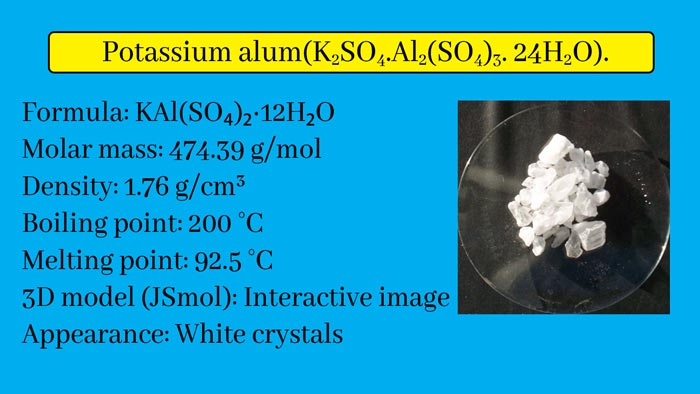Potassium Alum: Properties, Preparation, Uses
Alum is a double salts and its common formula is R2SO4.M2(SO4)3.24H2O.
Where
R = A valence metal Such as: K, Na, NH4
M = Tri valent metal Such as: Fe, Al, Cr
It is not necessary to write the name of a valence metal in which the potassium is present as a valence metal. Similarly, the name of tri-metal is not necessary to write the name of alum in which aluminium is present as trivalent metal.
- K2SO4.Al2(SO4)3.2H2O – Potassium alum
- (NH4)2SO4.Al2(SO4)3.24H2O – Ammonium Alum
- (NH4)2SO4.Fe2(SO4)3.24H2O -Ferric ammonium Alum
- K2SO4.Cr2(SO4)3.2H2O – Chromium alum

Pseudo Alums
They are also double salts but they have the common atomic RSO4.M2(SO4)3.24H2O.
Where
R = A valence metal Such as: Cu, Fe(II), Zn, Mg
M = Trivalent metal Such as: Fe(III), Al, Cr
Like:
MnSO4.Al2(SO4)3.24H2O
CuSO4.Fe2(SO4)3.24H2O
Potassium Alum
Potassium alum is also called ordinary alum or potash alum. If only alum or alum are used for the name of a substance, it usually means potassium alum. It is chemical name is potassium aluminium sulfate. Chemical formula of Potassium alum is KAl(SO₄)₂.

Preparation of Potassium Alum
By mixing the hot solutions of pot and aluminum in proportion to the corresponding weight, the crystals of ordinary alum are formed.
K2SO4 + Al2(SO4)3 + 24H2O → K2SO4.Al2(SO4)3.24H2O
Bauxite Method(Industrial Preparation)
Bauxite is heated by mixing it with concentrated H2SO4. And after filtering the solution, add the appropriate amount of potassium sulfate. Crystals of alum are obtained on cooling.
Al2O3 + 3H2SO4 → 3H2O + Al2(SO4)3
Al2(SO4)3 + K2SO4 + 24H2O → K2SO4.Al2(SO4)3.24H2O
Alunite method(Industrial Preparation)
The alunite is heated by mixing it with concentrated H2SO4 and after filtering the solution, add appropriate amount of potassium sulfate. Crystals of alum are obtained on cooling.
K2SO4.Al2(SO4)3.4Al(OH)3 + 6H2SO4 → K2SO4 + 3Al2(SO4)3 + 12H2O
K2SO4 + Al2(SO4)3 + 24H2O → K2SO4.Al2(SO4)3.24H2O
Physical Properties
It is a white crystalline substance. It is merged with water and is dissolved in alcohol. The alum solution in water is acidic.
Chemical Properties
Effect of heat: On heating to 92°C, it melts and crystal water is released and the dry matter remains which is called burnt alum.
K2SO4.Al2(SO4)3.24H2O → Al2O3 + K2O + 4SO3 + 24H2O
Effect of water: It dissolves in water and it gets divided into its ions according to the ionic principle. The properties of a solution depend only on the properties of the ions present in it.
K2SO4.Al2(SO4)3.24H2O → K2SO4 + Al2(SO4)3 + 24H2O
K2SO4 ⇌ 2K+ + SO42—
Al2(SO4)3 ⇌ 2Al3+ + 3SO42–
In addition to ionization of aluminum sulphate in the presence of water, its water decomposition also occurs.
Al2(SO4)3 + 6H2O ⇌ 2Al(OH)3 + 3H2SO4
Al(OH)3 and H2SO4 are formed due to water decomposition of aluminum sulfate, which is weak alkali and strong acid respectively. Hence, the aqueous solution of alum is acidic.
Effect of alkali: White precipitate of aluminium hydroxide is obtained by adding NaOH solution to alum solution, which dissolves in excess of NaOH.
K2SO4.Al2(SO4)3.24H2O → K2SO4 + Al2(SO4)3 + 24H2O
Al2(SO4)3 + 6NaOH → 2Al(OH)3 + 3Na2SO4
Al(OH)3 + NaOH → NaAlO2 + 2H2O
Similarly, white precipitate of aluminum hydroxide is also obtained by adding KOH solution to alum solution. Which dissolves in excess of KOH to form potassium meta aluminate(KAlO2).
Alum also gives a white precipitate with NH4OH. By filtering and separating this white precipitate, Al2(SO4)3 is obtained when dissolved in H2SO4 and alumina is obtained on heating.
K2SO4.Al2(SO4)3.24H2O → K2SO4 + Al2(SO4)3 + 24H2O
Al2(SO4)3 + 6NH4OH → 2Al(OH)3 + 3(NH4)2SO4
2Al(OH)3 + 3H2SO4 → Al2(SO4)3 + 6H2O
2Al(OH)3 + Al2O3 + 3H2O
Potassium Alum uses
The coagulating power of alum is high. It precipitates Colloidal Solution. This property of alum is used to stop the bleeding. It prevents blood from flowing through it.
The coagulating power of alum is also used in purifying water. It precipitates colloidal impurities present in the water, which can be filtered and separated.
It uses in calico printing
Leather is used in rubbing and in paper factories.
Used as a mordant in extinguishing fire and in dyeing of clothes.
Summary
Chemical Formula: KAl(SO₄)₂·12H₂O
Appearance: Potassium alum typically occurs as
colorless, odorless, octahedral crystals or white crystalline powder.
Solubility: It is soluble in water, with
solubility increasing with temperature.
pH: Potassium alum has an acidic pH in solution.
Density: The density of potassium alum is
approximately 1.75 g/cm³.
Melting Point: Potassium alum melts at around
92-95°C (197-203°F).
Boiling Point: Upon heating, potassium alum
undergoes dehydration and decomposition without boiling.
Stability: Potassium alum is stable under
normal conditions but decomposes upon heating.
Taste: It has a sweet and astringent taste.
Astringent Properties: Potassium alum is known for its
astringent properties and is often used in aftershaves, deodorants, and
antiperspirants to reduce sweat and body odor.
Antiseptic Properties: It also exhibits antiseptic
properties and has been used historically in various medical applications.
Mordant: Potassium alum is used as a mordant
in textile dyeing to help fix dyes to fibers.
Deodorizing Properties: It is used in foot powders and
deodorizing sprays to eliminate odor-causing bacteria.
Crystal Growth: Potassium alum crystals can be grown
as a fun and educational science experiment, often forming large, geometrically
shaped crystals.
Alum Baking Powder: Potassium alum is used in some
baking powders as a leavening agent.
Safety Precautions: While potassium alum is generally
considered safe for topical use, ingestion of large amounts can lead to
gastrointestinal irritation. It should be kept out of reach of children and
used according to instructions.
